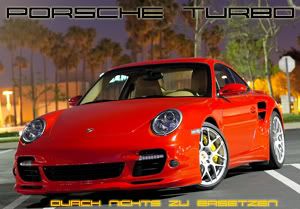I know the issue of power and dyno is going to come up, so below is the words of wisdom from AWE regarding how misleading a dyno could be. My understanding then is a dyno could be manipulated, including engine dyno. More valid confirmation could be done one of two ways:
1. Do 2 dyno runs, one pre and one post modificatiion, and look only for the delta -- the change between the 2 curves.
2. It's ideal to also have Vbox data http://www.vboxusa.com/ , under same conditions. This is why Alex's Performance Table is so cool; obviously not same conditiion, but this is not a perfect world. http://www.rennteam.com/forum/thread/433719/Performance_Table/page1.html
>>>>>>>>>>>>>>>>>>>>>>
http://forums.rennlist.com/rennforums/997-turbo-forum/486470-randy-probst-drives-aprs-997-turbo-2.html
Any load type dyno, whether Mustang, Maha, Dyno-Dynamics, or Dynapak, can be calibrated to show whatever you want them to show. The shape of the curve is linked to the load which is adjustable on all these dynos. The scale is linked to the software correction factors, which is adjustable on almost all these dynos. Therefore, there is not one "right" dyno as they are all at the mercy of their software parameter set-up.
HOWEVER, as long as the software parameters that are used for the baseline are ALSO used for the modification test, the results are valid, REGARDLESS OF SHAPE OR SCALE. Sorry for shouting, but this is an essential concept to understand. The "delta" or difference between the curves is all that matters as long as the load being supplied to the car is not unrealistic.
For example, we could have loaded up the 997 GT2 lower in the curve to produce more boost in that area which in turn would make the low end look more powerful. HOWEVER, such a load caused clutch slippage, which immediately told us we were loading the vehicle in an unrealistic manner. On an engine dyno, there is no clutch to worry about. But there is a clutch to worry about on the street and track, which is where the power is being used in the real world. Thus, clutch spec is an important factor to consider when looking at chassis dyno results.
The only major dyno that does not have variable load control is the Dynojet. Instead, they rely on a rather unconventional mathematical calculation of power as a function of how fast their known roller mass can be accelerated to a given speed. Without a variable load control, realistic adjustment to the vehicle is not possible, resulting in rather "isolated from reality" results, in my opinion and others.
>>>>>>>>>>>>>>>>>>>>>>>>
Yes, an engine dyno is just as susceptible. Engine dynos rely on software to convert raw sensor signals into mapped curves, and settings in that software can be changed just like with the software used on a chassis dyno.
So, unless all these settings are somehow used universally by all dyno operators, or if tuner dynos were subject to governing body regulation, not even the results from an engine dyno can be taken absolutely.
I am glad to see that this information is slowly seeping into the forum readers. We've been preaching this for years.
Bear in mind that there are a lot of variables that need to be controlled for Vbox runs, too, in order to make them universally comparable, like ambient temp, road surface/grade, headwind/tailwind, etc., but at least the TOOL being used for data capture is a "sealed box" for all intents and purposes.
--
Regards,
Can
997 Turbo + Bilstein Damptronic (Review) + Cargraphic Exhaust (Heavenly Race Car Noise  Review)
Review)





















 Thanks a lot for the encouragement and the effort to separate me and my hard earned $. During a recession no less. LOL.
Thanks a lot for the encouragement and the effort to separate me and my hard earned $. During a recession no less. LOL.





